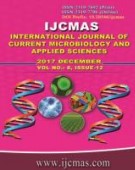


 National Academy of Agricultural Sciences (NAAS)
National Academy of Agricultural Sciences (NAAS)

|
PRINT ISSN : 2319-7692
Online ISSN : 2319-7706 Issues : 12 per year Publisher : Excellent Publishers Email : editorijcmas@gmail.com / submit@ijcmas.com Editor-in-chief: Dr.M.Prakash Index Copernicus ICV 2018: 95.39 NAAS RATING 2020: 5.38 |
Knitted fabrics are much in demand due to their snug fitting, stretchability, easy care, soft handle and wrinkle resistant quality suitable for sportswear and other casual wearing apparels. In the present situation, to meet the raw material crisis of natural fibres and to provide the textile industry with a low priced substitute of natural fibres; blending of manmade fibres are essential. Cotton is the best-suited fibre for blending with manmade fibres. The present work on weft knitted p/c blended knitted fabrics was done to meet the raw material crisis of natural fibres and to provide a low priced substitute of natural fibre to the textile industry. The blending and spinning of two fibres (cotton and polyester) was done by batch method and on open end spinning system with 40s respectively. Plain weft knitted fabric was produced from the blended yarns on circular weft knitting machine with 26-inch diameter. While comparing the cost of P/C blend with cotton fibre /yarn/fabric, it was found that 50:50 P/C blended yarn as well as fabric cost lesser as compared to 100 percent cotton. Effect of wear on constructional properties of weft knitted Polyester-cotton blended fabric was studied after different levels of wear and washing. It was concluded that constructional properties changed more after 10 washings and wears. Fabric count increased significantly after different level of wear. Fabric thickness and weight also increased significantly after ten wears but after that thickness and weight decreased. Variability was maximum in case of thickness (CV=4.25) and minimum for fabric courses (CV=1.34).Being the producer of cotton, the rural masses can take up or adopt knitting as a income generating source, to set up a small scale enterprise.
 |
 |
 |
 |
 |